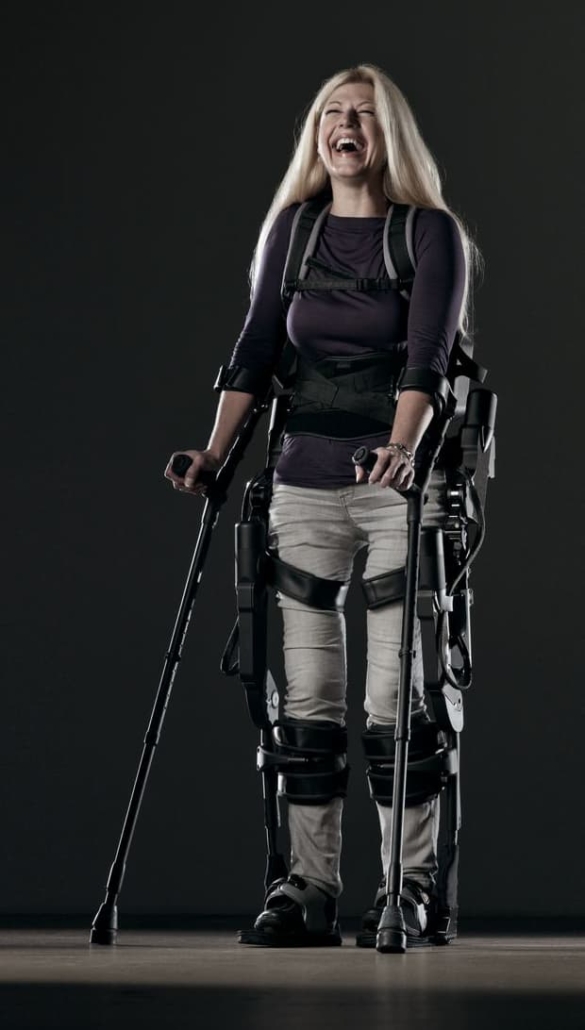New AI-powered exoskeletons poised to transform rehabilitation autonomy
Artificial intelligence could unlock the full potential of therapeutic and assistive exoskeletons by enabling autonomous operation, reducing dependence on therapists and caregivers. However, researchers emphasise that richer patient data and more accurate digital twins are essential before these technologies can achieve widespread clinical deployment and revolutionise rehabilitation outcomes.
A comprehensive review published in Science Robotics on 30 July 2025 reveals how machine learning techniques are already enhancing exoskeleton performance across multiple functional domains, from terrain recognition to real-time gait phase estimation. The research team, led by Herman van der Kooij from the University of Twente, presents a systematic analysis of current AI applications whilst identifying critical gaps that must be addressed for future clinical success.

An exoskeleton for rehabilitation from Ekso Bionics. For illustration only. © CC BY-ND 2.0 Ekso Bionics https://eksobionics.com/
Current AI capabilities show promise across multiple domains
The review demonstrates that AI has made substantial progress in several key areas of exoskeleton control. Deep learning algorithms now achieve over 98% accuracy in classifying locomotion modes and terrain conditions, enabling automatic controller adjustments without user intervention. “AI techniques have made substantial improvements in performance and autonomy, but there remain considerations for future research,” the authors note.
For therapeutic applications, AI has proven particularly valuable in serious game development and patient assessment. Machine learning algorithms can adapt game difficulty in real-time, maintain appropriate cognitive load during robot-assisted training, and provide verbal cues based on patient state. One study demonstrated that an AI therapist could provide effective verbal guidance during gait training by analysing data from 58 stroke survivors.
Neural networks have also revolutionised joint torque prediction, with temporal convolutional networks successfully estimating biological joint moments across 35 different ambulatory conditions. These end-to-end controllers can map sensor data directly to desired exoskeleton torques, eliminating the need for intermediate state estimation whilst achieving metabolic cost reductions during walking.
Simulation advances bridge reality gap for controller development
Reinforcement learning combined with digital human models represents a particularly promising development pathway. Recent breakthroughs have demonstrated successful transfer of controllers trained entirely in simulation to real-world exoskeletons, achieving metabolic improvements without requiring extensive human testing.
The authors highlight that “deployment-efficient RL does not rely on data but on accurate digital twins because learning on the physical human-exoskeleton combination is often not possible and is much more time consuming.” This simulation-to-reality approach could dramatically accelerate controller development whilst reducing the burden on patients during the research phase.
However, accurately modelling human-exoskeleton interactions remains substantially more challenging than robotic systems alone, particularly when accounting for diverse patient populations and pathological movement patterns.
Data limitations constrain clinical translation
Despite these technological advances, the review identifies significant barriers preventing widespread clinical adoption. Most critically, the vast majority of AI studies have relied exclusively on data from able-bodied individuals, raising serious questions about generalisability to patient populations.
“Most studies so far only included data from able-bodied individuals, whereas AI-based models have the risk of not generalising well when not properly trained,” the authors emphasise. Device-specific models trained on individual patient data consistently outperform general models, highlighting the poor transferability of results from healthy populations.
The lack of standardised validation methods further complicates progress assessment. “Because researchers use various nonuniform methods, if any, to validate the results of their algorithms, comparisons are sometimes difficult to make,” according to the review.
Future directions require integrated approach
Looking ahead, the researchers outline several critical development priorities. Enhanced sensor technology, including high-density electromyography electrodes and thin-film ultrasound transducers, could enable continuous monitoring of neuromuscular adaptation over weeks to months.
Large language models show particular promise for therapy planning, potentially translating high-level treatment goals into structured exercise programmes. The authors envision AI-powered systems that could eventually “bridge the gap between therapists and therapeutic exoskeletons by providing a translational module that can convert the medical terminology used by therapists into commands understood by automated robotic systems.”
For assistive applications, the integration of computer vision with advanced motion planning could eliminate the need for manual mode selection, enabling dynamic adaptation to environmental conditions in real-time.
Challenges remain for clinical deployment
The authors acknowledge several inherent challenges with AI implementation in medical devices. Deep neural networks’ complexity makes them less interpretable than traditional approaches, potentially complicating regulatory approval processes for medical applications.
Power consumption represents another practical limitation, as complex AI algorithms may strain the energy resources of wearable devices. The computational efficiency of algorithms processing visual data requires substantial improvement before practical deployment.
“The full potential of AI-powered exoskeletons has not been fully realized, and much research and development lie ahead,” the authors conclude, emphasising the need for more rigorous benchmarking against state-of-the-art non-AI methods.
The review suggests that whilst individual AI components show considerable promise, achieving true autonomy will require seamless integration across all functional domains, supported by comprehensive patient databases and validated digital twin technologies.
Reference
van der Kooij, H., van Asseldonk, E. H. F., Sartori, M., et. al. (2025). AI in therapeutic and assistive exoskeletons and exosuits: Influences on performance and autonomy. Science Robotics, 10(94), eadt7329. doi: https://doi.org/10.1126/scirobotics.adt7329

